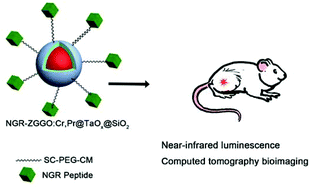Radiopaque tantalum oxide coated persistent luminescent nanoparticles as multimodal probes for in vivo near-infrared luminescence and computed tomography bioimaging†
Abstract
The design and fabrication of multimodal imaging nanoparticles is of great importance in medical diagnosis. Here we report the fabrication of core–shell structured Zn2.94Ga1.96Ge2O10:Cr3+,Pr3+@TaOx@SiO2 nanoparticles for persistent luminescence and X-ray computed tomography (CT) imaging. Persistent luminescent nanoparticles Zn2.94Ga1.96Ge2O10:Cr3+,Pr3+ were used as the core to provide near-infrared luminescence, and a TaOx layer was grown on the core to serve as the contrast agent for CT. The tenuous outermost SiO2 shell was fabricated on the TaOx layer to gain high biocompatibility and to facilitate post-modification with tumor-targeting peptides. The fabricated core–shell structured nanoparticle shows intense near-infrared luminescence and the CT contrast effect. No obvious mutual interference was found in these two modalities, which ensures that each imaging modality merits could be brought in a full play. Furthermore, covalent bonding of cyclic-Asn-Gly-Arg peptides makes the core–shell structured nanoparticles promising for in vivo targeted imaging of tumor-bearing mice.


 Please wait while we load your content...
Please wait while we load your content...